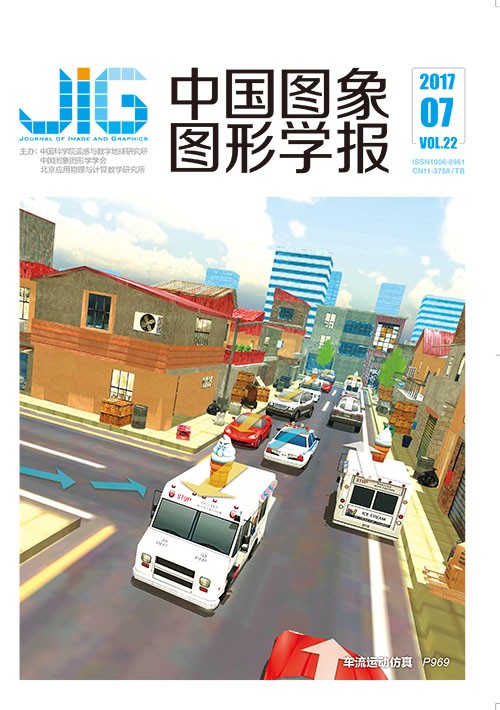
高分辨卫星图像卷积神经网络分类模型
摘 要
目的 卫星图像往往目标、背景复杂而且带有噪声,因此使用人工选取的特征进行卫星图像的分类就变得十分困难。提出一种新的使用卷积神经网络进行卫星图像分类的方案。使用卷积神经网络可以提取卫星图像的高层特征,进而提高卫星图像分类的识别率。方法 首先,提出一个包含六类图像的新的卫星图像数据集来解决卷积神经网络的有标签训练样本不足的问题。其次,使用了一种直接训练卷积神经网络模型和3种预训练卷积神经网络模型来进行卫星图像分类。直接训练模型直接在文章提出的数据集上进行训练,预训练模型先在ILSVRC(the ImageNet large scale visual recognition challenge)-2012数据集上进行预训练,然后在提出的卫星图像数据集上进行微调训练。完成微调的模型用于卫星图像分类。结果 提出的微调预训练卷积神经网络深层模型具有最高的分类正确率。在提出的数据集上,深层卷积神经网络模型达到了99.50%的识别率。在数据集UC Merced Land Use上,深层卷积神经网络模型达到了96.44%的识别率。结论 本文提出的数据集具有一般性和代表性,使用的深层卷积神经网络模型具有很强的特征提取能力和分类能力,且是一种端到端的分类模型,不需要堆叠其他模型或分类器。在高分辨卫星图像的分类上,本文模型和对比模型相比取得了更有说服力的结果。
关键词
Convolutional neural network models for high spatial resolution satellite imagery classification
Zhou Mingfei, Wang Xili, Wang Lei, Chen Fen(School of Computer Science, Shaanxi Normal University, Xi'an 710119, China) Abstract
Objective Satellite imagery classification is a task that uses classification models to divide a set of satellite images into several classes. The satellite images discussed in this paper are collected from the Quickbird satellite imagery dataset. Satellite images are divided into six classes, namely, airplanes, dense residential areas, harbors, intersections, overpasses, and parking lots. Generally, the task of satellite imagery classification is difficult because of the complex targets and backgrounds in satellite images. Traditional methods, such as the artificial neural networks and support vector machines, usually use low-level and manually selected features. These features are insufficient and cannot represent the multi-level and intrinsic features of satellite images. Simultaneously, obtaining high accuracy is difficult through the classification methods, which use low-level features. Some deep learning methods use pre-trained convolutional neural networks to extract the high-level features of satellite images and some classifier to classify satellite images. These methods can improve their performance than the traditional methods. However, these methods ignore the inherent classification capability of convolutional neural networks because considerable labeled training data of satellite images are required to train a convolutional neural network, which could extract features and classify images simultaneously; however, training data are limited in practice. Other methods use a stack of shallow convolutional neural networks to classify satellite images. However, the stack of low-level features remains insufficient representative to substantially improve the classification accuracy of satellite image. In this paper, a new approach using deep convolutional neural networks is presented to improve the classification accuracy for satellite imagery. The classification accuracy of satellite images could be improved using the deep features extracted by convolutional neural networks. Method An end-to-end training and classification method is proposed. This method does not require additional classifiers and stack of shallow convolutional neural networks to improve the capability of feature extraction from satellite images. First, a new satellite imagery dataset, which contains six classes, is proposed to deal with the problem of lacking labeled training data. Second, three kinds of pre-trained deep convolutional neural network models and a directly trained shallow convolutional neural network model are used to perform the classification task for satellite images. The shallow model has low training weights and can be trained directly on the satellite image dataset to classify satellite images. The proposed three kinds of deep models should be pre-trained on an auxiliary dataset, because the amount of the training weights of the three deep models is too large to be directly trained on the proposed satellite images dataset. The three kinds of deep models are pre-trained on a large auxiliary dataset, which contains roughly 1 200 000 labeled training images of 1 000 classes. All of the images contain the common objects, which could be viewed everywhere in the daily life. The weights of the three deep architectures of convolutional neural networks can be trained adequately after pre-training on the large auxiliary dataset. The capability of the deep models to extract representative features and to classify images can be improved after pre-training, and the application objects of the models can be transferred from the daily common objects to the satellite image objects. The key point of such transformation is fine-tuning the pre-trained deep models on the proposed satellite image dataset. The architectures of the three deep models should be changed slightly and then they could be fine-tuned on the proposed dataset. After fine-tuning, the three deep convolutional neural network models could be used to classify satellite images directly without using other classifiers or stacked shallow models. Result The proposed convolutional neural network models are validated on two datasets. One of the testing satellite images datasets is the proposed dataset, and the other dataset is the famous UC Merced land use dataset. The four proposed models demonstrate high performance on the proposed dataset. The classification accuracies of the three deep models are higher than the accuracy of the shallow model. In particular, the deepest convolutional neural network model achieves the highest accuracy of 99.50% on the proposed dataset. The results of the UC Merced land use dataset of the three similar methods in the literature are compared with the results of the proposed models. Two of the three comparative methods use the features extracted from the pre-trained convolutional neural networks without fine-tuning and use an additional classifier to classify satellite images. The other method uses a multi-view convolutional neural network to perform the classification task. Experimental results indicate that the proposed deep models in this paper achieve the highest accuracy(96.44%) among all the models. Conclusion This paper proposes a new satellite image dataset, which is representative of satellite images. Convolutional neural networks could be trained adequately through the proposed satellite image dataset. Shallow convolutional neural networks can possibly be directly trained on this dataset. Pre-trained convolutional neural networks obtain better classification accuracy on other satellite imagery dataset after fine-tuning on the proposed dataset. Furthermore, the proposed deep convolutional neural network models are effective in terms of deep feature extraction and satellite image classification. The proposed models obtain more competitive results than other reported methods in literature. The proposed deep models exhibit good generalization capability and could achieve high accuracy on the UC Merced land use dataset, in which images differ from those in the fine-tuning dataset in terms of scale and quality. The effective pre-training and fine-tuning with the depth of the proposed deep models contribute to the good performance of the models. In addition, the proposed models are end-to-end models. Additional classifiers and stack of the shallow models are not required to classify satellite images.
Keywords
|



 中国图象图形学报 │ 京ICP备05080539号-4 │ 本系统由
中国图象图形学报 │ 京ICP备05080539号-4 │ 本系统由